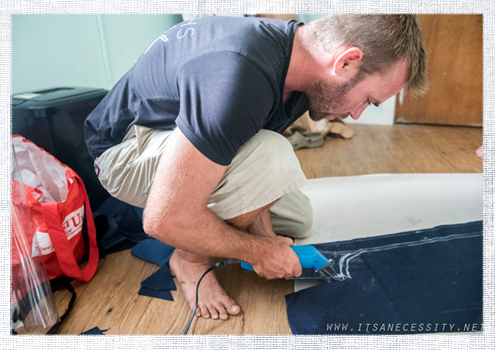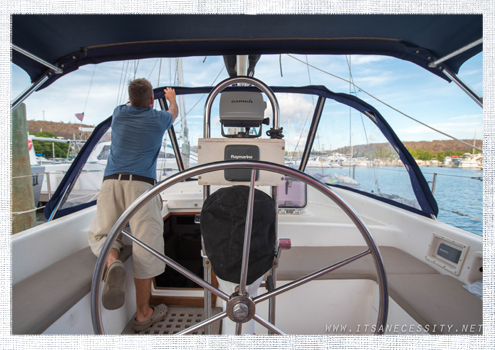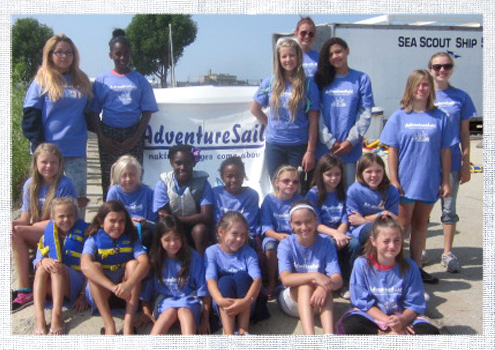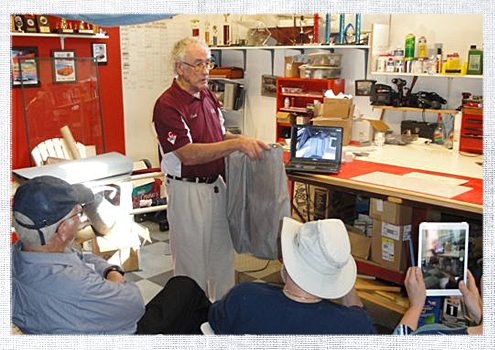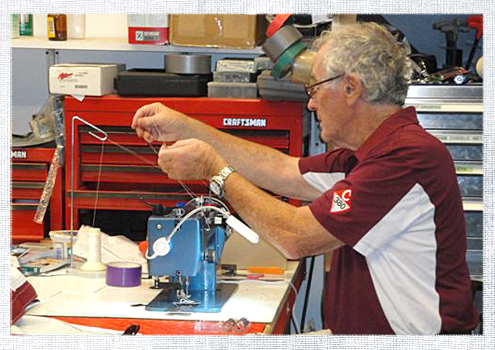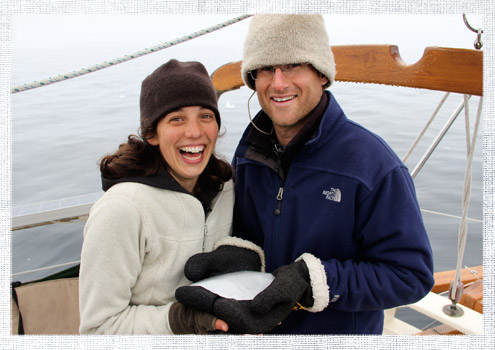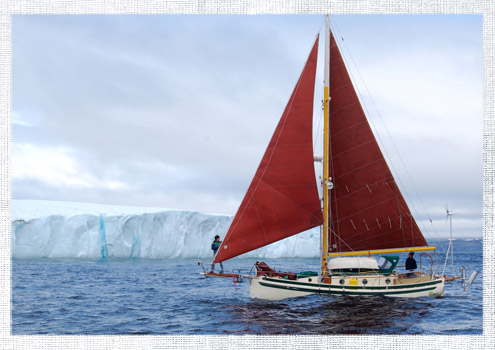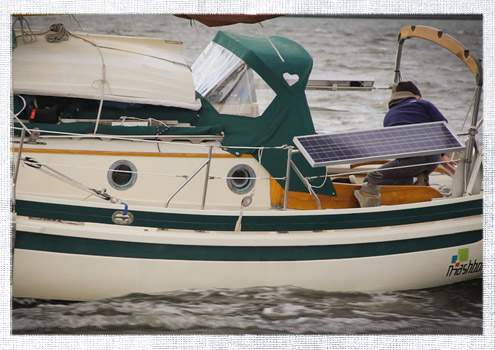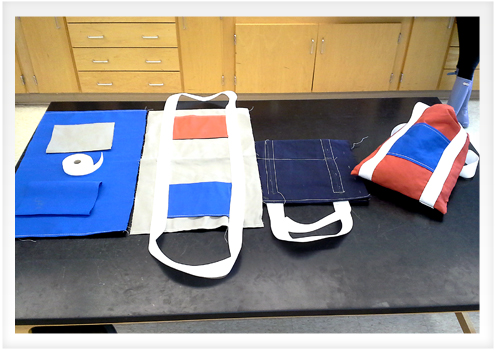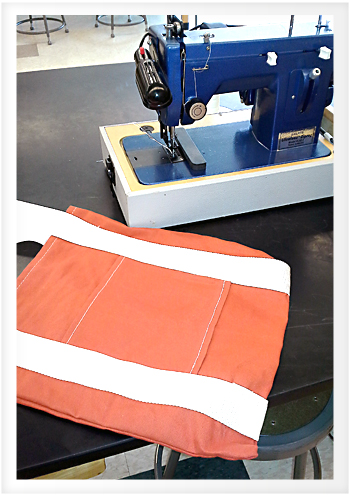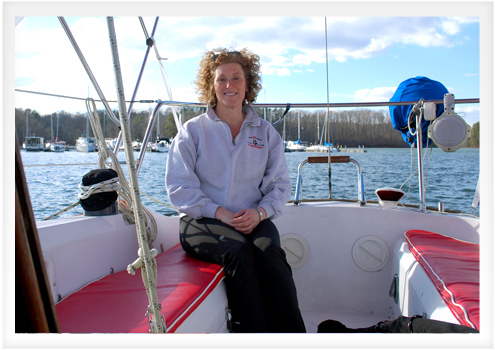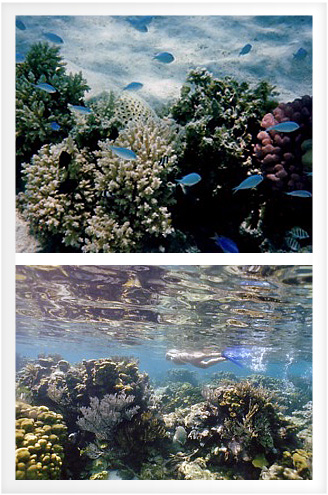Sailrite is proud to sponsor the DIY efforts of Eben and Genevieve Stolz, the dynamic duo behind the cruising blog It’s a Necessity.
Eben and Genevieve Stolz know the DIY lifestyle. A few years ago, in order to maintain their cruising lifestyle with their two daughters, Arias and Ellia, the couple needed a bigger boat. They found that boat, S/V Necesse (a 41-foot Morgan Classic and a total fixer-upper) in Georgetown, Bahamas and sailed her back to Miami, Florida for a re-fit.

The whole family: Eben, Genevieve, Arias & Ellia
They spent two years of hard work redoing nearly the entire interior before they set sail again. Now this hard-working cruising family is back at their boat projects while waiting out hurricane season in the Virgin Islands. I recently got the chance to talk with Eben about his latest DIY projects and his experience as a DIY sailor.
One of the recent and biggest projects Eben took on for their boat was building a dodger. The dodger project was one Eben had been mulling over in his mind for years before he set to work.
“I bought Strataglass and Sunbrella fabric from [Sailrite] like three years ago and did my bimini,” he said.
Eben had always planned on making a matching dodger, but without a template to follow for the project, he decided to wait and think the project through more before starting.
“I sit and look at things for a while,” Eben said.
He recently got the push he needed to finally start on his dodger when a fellow cruiser lent him old VHS tapes outlining how to build a dodger. The video didn’t do things exactly the way Eben wanted for his boat, but it gave him a good starting point. So he pulled out his materials from storage and set to work bending and building the frame.
After bending all the tubing by hand on his boat, Eben installed the dodger frame. Then he used the frame to template the fabric panels. Friends of his had offered him their office space to sew in, so he took his templates and fabrics to land to sew it all together.
In the office, Eben laid painters drop cloths on the floor to keep his Strataglass from scratching during fabrication. Then he patterned and basted all the pieces together and started sewing on his Ultrafeed LSZ-1 Sewing Machine.
“I was a little worried about sewing the 40 Gauge Strataglass,” he admits. “I didn’t know if the machine would handle it.”
But once Eben started sewing, his fears were quickly assuaged. “[The machine] went through it like butter,” he laughed.
Throughout the process Eben was meticulous in his planning so everything would come out just right, carefully adding zippers around the whole frame and installing fasteners one at a time to ensure a perfect fit. The close attention to detail really paid off and the finished dodger looks great. Genevieve wrote on their blog that the dodger “gives our boat a whole new feel.”
Eben said the most challenging part of the dodger project was the surroundings he had to sew in. Having a small space to sew a large project meant having to roll the Strataglass to sew while being careful not to scratch it and sewing slowly to make frequent adjustments.
“Not having a huge space and not having an even plane with your sewing machine to sew on [was a challenge],” he said. “It’s feasible but it’s not like having a sail loft to work in.”
Eben has a long history with DIY and sewing especially. He started sewing when he was just 10 or 11 years old because his older brother had taken up the hobby. Together they started sewing their own snowboarding gear.
He says he’s always had a DIY spirit and a drive to learn new things.
“People say I have a lot of talents, but I don’t. I just think I can do anything,” Eben said. “If someone else is doing it, I want to figure out how to do it, too.”
Eben eventually fell away from sewing until he and Genevieve were living in Miami working on their boat refit. There he met a guy with a canvas shop who hooked him up with a Sailrite Ultrafeed LSZ-1 Sewing Machine and Eben started sewing for the boat. He made their bimini and all new cushions for their salon.
He now describes his Ultrafeed Sewing Machine as his “number one tool.”
“Every day I use it I’m impressed,” he said.
One of the features Eben really likes about the Ultrafeed is that it doesn’t draw a lot of energy, so he can run it off his Honda generator. He frequently takes the generator and the Ultrafeed out to the beach to sew.
“The Sailrite weighs more than the generator, so that says something about quality,” Eben said, laughing.
Having his sewing machine onboard also means that he frequently gets requests from other sailors to sew projects for them. He recently made “bat wing” boom awnings for cruising friends and has plans to help a neighbor with a dodger. Aside from helping fellow cruisers sew boat projects, he’s never sewn officially as a job.
Eben said he focuses his efforts on projects for their own boat.
“It gets expensive being in the boating world,” he said.
Eben’s two other go-to tools for his canvas projects are the Pres-N-Snap Tool and the Sailrite Edge Hotknife.
“Those are amazing,” he exclaimed.
Eben described how he would carefully and meticulously hem all the edges of Sunbrella projects before having a hotknife to ensure none of his edges would ravel.
“The hotknife is the best thing available for sewing. Having the hotknife saved me 6-7 hours of work on the dodger and really put my mind at ease that nothing would unravel,” he said.
Eben shared his advice for other DIY sailors looking to sew their own canvas projects.
“Think you can do anything,” he said.
Eben also recommends careful planning and being methodical in your approach.
“Waste time over planning,” he said. “You know how they say ‘measure twice, cut once’? I’m more measure seven times, cut once.”
He also recommends taking advantage of all the sewing resources available online and over the phone.
“Use the assets available—use Sailrite’s customer service,” he said. “Sewing can be a pain when things go wrong but you can be on the right track again with just a phone call.”
To learn more about Eben and Genevieve and to follow their cruising journey, visit their blog, It’s a Necessity or follow them on Facebook & Instagram (@sailing_necesse).
